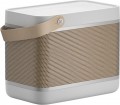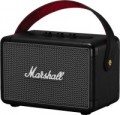Sources and media
—
Bluetooth. Wireless technology for transmitting sound from mobile phones, tablets, etc. Allows you to connect a device wirelessly at a short distance from the signal source. The quality and overall capabilities of Bluetooth vary depending on the version:
Bluetooth 4. Each version brings improvements relative to the previous one. So in version 4.0, three standards were actually combined: traditional Bluetooth, a high-speed channel and an energy-saving mode for small amounts of data. This allowed us to optimize channel usage and battery consumption. In version 4.1. Noise immunity has been enhanced when working next to 4G LTE modules. And version 4.2 introduced mainly general improvements in speed and security.
Bluetooth 5.0. One of the most important innovations of the Bluetooth 5.0 standard is the expansion of the capabilities of the BLE (Bluetooth Low Energy) mode: if necessary, the device can increase the range by reducing the speed, or speed up transmission by reducing the range. In addition, a number of improvements have been introduced regarding simultaneous work with multiple connected devices.
-
Bluetooth 5.1. A significant upgrade in version 5.1 was the ability to accurately position the signal transmitter (receiver). If previous versions could only determine distance, then version 5.1 can also determin
...e direction. Thus, navigation began to function better and more accurately, which improved work with the smart home system, searching for connected devices, etc. In addition to this, the improvements again concerned saving energy consumption and simultaneous work with several connected devices.
- Bluetooth 5.2. The next update, after 5.1, is Bluetooth 5th generation. The main innovations in this version are a number of security improvements, additional optimization of power consumption in LE mode and a new audio signal format for synchronizing parallel playback on multiple devices.
— Bluetooth 5.3 The Bluetooth v 5.3 wireless communication protocol was introduced at the dawn of 2022. Among the innovations in it, they accelerated the process of negotiating a communication channel between the controller and the device, implemented the function of quickly switching between the operating state in a low duty cycle and a high-speed mode, and improved the throughput and stability of the connection by reducing susceptibility to interference. When unexpected interference occurs in Low Energy mode, the procedure for selecting a communication channel to switch from now on has been accelerated. There are no fundamental innovations in protocol 5.3, but a number of qualitative improvements are evident in it.
- Bluetooth 5.4. The version was presented at the beginning of 2023, the range and data exchange speed were increased. Also in Bluetooth v 5.4, the energy-saving BLE mode has been improved. This protocol uses new security features to protect data from unauthorized access, has increased connection reliability by selecting the best channel for communication, and prevents connection losses due to interference.
—Mini-Jack (3.5 mm). Standard Aux audio input for connecting speakers to an audio source, such as a laptop or smartphone.
- USB. The presence of a USB connector allows you to connect a flash drive, mobile phones, MP3 players and other similar peripherals to the portable speakers. Accordingly, such models have a built-in player and allow you to use connected gadgets exclusively as a drive.
- Card reader. Like the USB described above, this item implies the presence of a built-in player in the acoustics. And the card reader allows you to use memory cards as a drive on which songs will be recorded.
— FM receiver. A built-in tuner allows the speaker system to work as a full-fledged FM radio receiver - this is the range that is popular among music radio stations (in particular, due to the ability to broadcast sound in stereo format).Number of channels
—
Mono. The simplest type of acoustics is a single-channel audio system equipped with one speaker. Of course, there is no question of any volume of sound.
—
Stereo. Acoustic system equipped with two speakers responsible for the left and right channels. Allows you to create a minimal illusion of "surround" sound by simulating the displacement of the sound source in the space in front of the listener.
—
2.1. A system of two stereo speakers that create a minimal illusion of "surround" sound, and a subwoofer that provides powerful and rich sound at low and ultra-low frequencies.
Signal-to-noise ratio
The ratio of the level of the useful signal (the actual sound being reproduced) to the level of extraneous noise provided by the speaker amplifier in normal mode.
Any amplifier inevitably creates its own noise; You cannot get rid of them, but you can reduce their level. The higher the signal-to-noise ratio, the cleaner the sound will be, the less noticeable extraneous interference will be. However, it is worth keeping in mind that the signal-to-noise ratio is far from the only parameter that affects sound quality, and its high value does not guarantee pleasant sound from the speakers.
Sound pressure level SPL
The SPL (Sound Pressure Level) parameter determines the sound volume of portable acoustics. This indicator is expressed in decibels (dB). The higher the SPL, the louder and farther the sound produced by the speaker travels. It is important to consider that decibel is a non-linear quantity. In other words, increasing the volume from 20 dB to 40 dB or from 40 to 80 dB does not mean increasing it by 2 times. Therefore, when making an assessment, it is most convenient to refer to comparative tables of noise levels in special sources.
Passive emitter
The presence of a
passive radiator in the design of the speaker system.
Such an emitter is a speaker cone that does not have its own coil and magnet — in other words, it does not produce sound itself, but only vibrates from the sound of other speakers. Like the phase inverter (see above), this part is intended to improve sound pressure and sound depth, especially at low frequencies; at the same time, the advantage of a passive radiator is the absence of a tube, due to which the design is simpler and more compact than with a phase inverter.
Output power
The total power of all channels of the speaker system. The higher the power, the larger the size of the room in which the audio system can be used, however, more
powerful portable speakers usually have larger dimensions and weight.
Frequency range
The range of audio frequencies reproduced by the audio system. The wider the range, the richer the sound, the more details the speakers can convey, especially in the low and high frequencies. At the same time, we note that the average human ear is able to hear sounds in the range of about 16 – 20,000 Hz, and it makes no sense to provide a wider range in speakers — a person simply will not hear it. Also note that a wide frequency range alone does not guarantee good sound quality.
Speaker synchronization
The model supports the ability
to synchronize the operation of several speakers connected to one signal source. This solution allows you to realize truly stereo sound, improve the quality and power of sound reproduction, and also expand the stereo panorama. The only thing is that both speakers must support the appropriate connection type. Different brands may have their own technologies for combining speakers (JBL Connect, JBL PartyBoost, Sony Party Chain), or maybe a universal TWS.
Codec support
Initially, sound transmission via Bluetooth involves quite strong signal compression, which can greatly spoil the experience when listening to music. To eliminate this drawback, various technologies are used (the most popular of which
is the aptX codec). Of course, to use any of the technologies, it must be supported not only by the sound system, but also by the Bluetooth device with which it is used.
- aptX. A Bluetooth codec designed to significantly improve the quality of audio transmitted over Bluetooth. According to the creators, it allows you to achieve quality comparable to Audio CD (16-bit/44.1kHz). The benefits of aptX are most noticeable when listening to high-quality content, but even on regular MP3 it can provide a noticeable sound improvement.
- aptX HD. This codec is a further development and improvement of the original aptX technology, allowing you to transmit sound in even higher quality - Hi-Res (24-bit/48kHz). According to the creators, this standard allows you to achieve signal quality superior to AudioCD and sound purity comparable to wired communication. The latter is often questionable, but it can be argued that overall aptX HD provides very high sound quality. On the other hand, all the advantages of this technology become noticeable only on Hi-Res audio - with quality 24-bit/48kHz or higher; otherwise, the quality is limited not so much by the characteristics of the connection as by the propertie
...s of the source files.
- aptX Low Latency. A specific version of aptX described above, designed not so much to improve sound quality, but to reduce delays in signal transmission. Such delays inevitably occur when working via Bluetooth; They are not critical for listening to music, but when watching videos or playing games, there may be a noticeable desynchronization between the image and sound. The aptX LL codec eliminates this phenomenon, reducing latency to 32 ms - such a difference is imperceptible to human perception (although for serious tasks like studio audio work it is still too high).
- A.A.C. A codec used primarily in Apple portable devices to improve sound transmitted via Bluetooth. In this sense, it is similar to aptX (see the corresponding paragraphs), but is noticeably inferior to it in terms of capabilities: if the sound of aptX is compared with Audio CD, then AAC is at the level of an average quality MP3 file. However, for listening to the same MP3s, this is quite enough; the difference becomes noticeable only on more advanced formats.
-LDAC. Sony's proprietary Bluetooth codec. It surpasses even aptX HD in terms of bandwidth and potential sound quality, providing performance at the Hi-Res level of 24-bit/96kHz audio; there is even an opinion that this is the maximum quality that it makes sense to provide in wireless headphones - further improvement will be simply imperceptible to the human ear.
